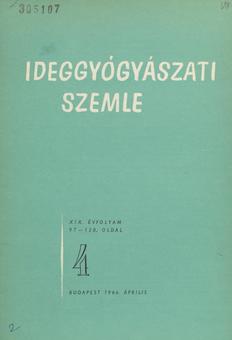The eLitMed.hu medical portal uses computer cookies for convenient operation. Detailed information can be found in the Cookie-policy.
Clinical Neuroscience - 1966;19(04)
Content
[Corticosteroid fractions in the human brain]
[In cases of 1) pneumonia, 2) sudden death from cardiac arrest, 3) sudden death from cardiac arrest in an alcoholic state, and 4) vehicle hit-and-run hemorrhage or spinal cord rupture, extracts were obtained from 5 brain areas of 10 people aged 21-72 years 2-9 hours after death and subjected to paper chromatography in a Bush 5 system. The extracts were run with the following corticosteroids as standard : 1. tetrahydrocortisol, 2. tetrahydrocortisone, 3. cortisol (hydrocortisone), 4. cortisone, 5. corticosterone, 6. 11-dehydrocorticosterone - Brain areas studied : 1. bridge + rabbit brain, 2. cerebellum, 3. cerebellar peduncles, 4. cerebral cortex, 5. cerebral white matter. 1. a total of 11 steroid variants were detected, 6 of which were identical to the standards, the other 5 unidentified steroids were designated X, (Rf. 0.03), X2 (Rf. 0.06), X3 (Rf. 0.19), X4 (Rf. 0.66), X5 (Rf. 0.70). 2. These steroids were detected in different amounts and qualities in different brain areas depending on the deaths. 3. The highest amounts of cortisol (hydrocortisone) and corticosterone were detected. Other fractions were present in varying numbers and qualities in different brain areas. 4. Most of the fractions and the highest amounts were found in the brain areas of those who died of pneumonia. This was followed by the brain areas of those who died suddenly due to heart failure. In third place were the brain areas of those who died of cardiac paralysis in an alcoholic state and in fourth place, i.e. the fewest fractions and the smallest amount of fractions were found in the brain areas of those who died of an accident in an alcoholic state. 5. In agreement with the results of our previous animal studies, it was found that the number and amount of corticosteroid fractions in all areas of the human brain were significantly lower after alcohol compared to those in those who died of other causes. 6. No seemingly regular order in the total steroids in the brain areas of those who died of pneumonia could be established. 7. In those who died suddenly from heart failure and in the hemorrhagic case, most steroids were found in the area of the bridge + rabbit brain, second was the steroid content of the cerebellum, third was the brainstem, fourth was the cerebral cortex and fifth was the white matter of the cerebrum. Only in the case of rabbit brain laceration was the steroid content of the rabbit brain + bridge and cortex (presumably due to the lesions) lowest compared to the other three brain areas. 8. Further studies are needed to determine whether age, sex, and the time between death and examination (more than 10 hours) influence the amount, number and size of corticosteroid fractions in each brain area. ]
[Methodology and place of gamma encephalography in neurological diagnosis]
[After a general physical introduction, the authors describe the methodology of gamma encephalography (GEG) with J131-labelled serum al bumin (RISA). After describing the advantages and disadvantages of the method, they discuss in detail the cases in which a reliable result can be expected from GEG. ]
[Method for measuring the synchronization of EEG curves]
[Today, there are about half a dozen mathematical-statistical methods that allow a more precise and refined analysis of EEG curves than ever before. These methods, above all autocorrelation (Brazier and Casby, Brazier and Barlow), Fourier analysis (Dietsch, Hajtman and Dési) and the various averaging methods, are essentially analytical in nature. They break down the activity under study into its components according to given mathematical formulae and filter out the regular, the periodic and the average from the sea of random variations. We believe that an exhaustive and in-depth study of the electroencephalogram requires the use of all these methods, because each of them answers a different question and is based on a different mathematical principle. ]
1.
Clinical Neuroscience
[Headache registry in Szeged: Experiences regarding to migraine patients]2.
Clinical Neuroscience
[The new target population of stroke awareness campaign: Kindergarten students ]3.
Clinical Neuroscience
Is there any difference in mortality rates of atrial fibrillation detected before or after ischemic stroke?4.
Clinical Neuroscience
Factors influencing the level of stigma in Parkinson’s disease in western Turkey5.
Clinical Neuroscience
[The effects of demographic and clinical factors on the severity of poststroke aphasia]1.
2.
Clinical Oncology
[Pancreatic cancer: ESMO Clinical Practice Guideline for diagnosis, treatment and follow-up]3.
Clinical Oncology
[Pharmacovigilance landscape – Lessons from the past and opportunities for future]4.
5.



